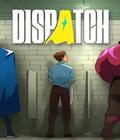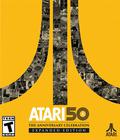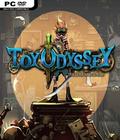Once a rarity in the video game landscape, the roguelike genre has become quite common among indie developers. About as common as the first-person shooter was in the previous generation, it has long reached a point where you need a distinct hook if you plan to attract the attention of a player who's being inundated with options. To that end, Toy Odyssey: The Lost and Found tries something a little new. Whether or not it was a good decision depends on your tolerance for the game and genre's quirks.
Toy Odyssey tells the story of Brand, an action figure owned by a child named Felix. While he is an ordinary toy by day, he comes alive at night along with all of the other toys in the house. Most of them are friendly enough, but those that have been lost by other owners have, over time, become corrupted by a dark force. As the boy's favorite toy, it is up to Brand to rescue the uncorrupted toys that are trapped in the ever-changing house and put a stop to the dark forces.
The story is fine, though it's a slow burn considering the overall pacing. One thing that helps the tale during those long lulls are diary pages scattered throughout the house. Each page belongs to a different member of one family, and it does a great job of painting their dire situation and indirectly explaining why the vengeful spirit exists in the house. Coming across those pages is randomized, so it can take quite a long time before you get an idea of what happened to just one person, let alone the whole family.
On the surface, the game is a side-scrolling platformer in the same vein as a Metroidvania title. Once you venture out of Felix's room, you explore the house on a room-by-room basis. Most of the time, the passages to new rooms are locked and require you to find a key to press forward. If you're lucky, you'll encounter rat holes, ventilation shafts, and other warps to reach other areas of the house. For the most part, your compatriots back at the base will give you a quest beforehand, so you have a goal to achieve, whether it's investigating certain rooms in the house or rescuing other toys that have been imprisoned but not yet corrupted. Even without a quest at hand, you'll spend your exploration time gathering lots of bolts and materials. The bolts act as currency and a means of leveling up, while the materials help you construct weapons, provided you found the appropriate cards for them.
The base mechanics mostly work, and the addition of resource gathering and warps to new areas are certainly beneficial. At the same time, this portion of the game already displays a few things that are either perplexing or simply actively work against the player for no discernable reason. For example, the title has no problem bringing Brand into a room and immediately setting him near an enemy or having an enemy attack him before he can do anything. Brand also isn't as strong as one hopes he would be, as he can take fall damage from pretty short heights. The game happens to be very fond of precarious platforms, making it very easy to fall. On top of that, while you may gain new weapon cards, you can't use any of them since you need to get their predecessors first. As a result, you'll get a cache of really strong weapons, but you can't do anything until you stumble upon their weaker, unevolved versions.
As alluded to earlier, many familiar elements of the roguelike genre are on display in Toy Odyssey. Death comes easily in the early stages, when you're at your weakest; you only become stronger and more formidable after surviving the various stages multiple times. Unlike other roguelikes, you get to keep everything you acquire on your last run, so the losses aren't great. However, the layout of the house changes — as does the layout of each room. This means you'll run into instances where you'll see the living room appear on multiple floors, for example, but at least the experience will be fresh.
It's easy to see why some of the roguelike elements work to the game's favor. It keeps exploration fresh, a necessity considering how often you'll go through them for quests and items. Unless you're a fan of a particular setup, death is the fastest way to go home, since you aren't penalized by losing stuff and losing a fight isn't that devastating.
At the same time, some of the elements that benefit portions of the game also actively hurt it. In particular, completing some of the quests can be a nightmare, since you may be required to reach a room that might not exist in your current configuration. You'll have to die quite often to get the room to appear, and failing the quest can mean that you'll need to suffer a few more deaths to get another chance.
Thrown in the middle of all of this is a light tower defense mechanic. At the end of each night, you'll be told whether the enemy toys have come over and raided your base for materials. While you can leave things to chance, you can choose to use materials to build defenses and other fortifications to either lessen the amount of lost goods or prevent them from being taken altogether. It's a passive activity more than an active one, so you only notice it when you die and get a nightly status update.
With all of these things put together, the game can quickly become one giant grind unless you get lucky on multiple fronts. Enemies tend to steal lots of goods, and it takes a number of goods to just build a fortification, never mind leveling up. The same applies to the weapon upgrades you want to construct. As mentioned earlier, the highly randomized nature of the world means it'll take a long time to complete the most menial quests. The result is a game that can seem like it's taking forever to progress in, and finally getting something done is met with relief rather than elation or accomplishment.
Graphically, the game is fine in some parts. The painted style for the stage backgrounds is nice, and though they aren't animated as robustly as Brand is, the other toys and creatures look good, with some nice details here and there. The frame rate holds up pretty well, and the game isn't afraid of having lots of things moving around on-screen at once. Give it enough time, though, and you'll see those same things betray the game. Some of the foreground elements that give the scene depth are too good at hiding enemies, and the darker lighting combined with the colors make the shurikens from very difficult to see. It can be tough to tell which pieces of furniture you can walk through and which ones will be solid once you jump on them. The text for the game is also tiny, which is odd since the title was also made for the Xbox One, and you expect console games to have text that's legible from further distances.
Likewise, the sound starts off well. The voices for each of the toys are nicely cast, and the delivery is close to perfect. The music conveys the hidden horrors of the house well and sets up each room encounter as treacherous. There is an issue with volume balance, as the score can sometimes overpower the voices enough that they're barely heard, but that isn't as bad as the fact that the audio is generally inconsistent. Your footsteps are much louder than anything else in the game, so stomping around on the metal floors of a ventilation shaft is as loud as enemy gunshots. While the opening moments of the game provide voice, that all but disappears when you talk to someone you've already met. The music also doesn't seem to match up with each room. You can be in the kitchen and suddenly hear the distant calls of a baby crying, even though the nursery might not exist in your current house configuration. Worse, the tracks are short, so you'll hear silence for a good stretch of time between musical snippets.
If you can deal with the constant grind that comes from the raids and randomness of each playthrough, Toy Odyssey: The Lost and Found can be good. Despite a number of flaws, the overall gameplay is entertaining, and the story is interesting once you get enough pieces together. It isn't flawless in its many technical areas, but the job it ultimately does is more than adequate. That grind still hurts, and those looking for more structure and a better sense of progression in their titles would be better served elsewhere.
Score: 6.0/10
More articles about Toy Odyssey: The Lost and Found











 Toy Odyssey: The Lost and The Found is a Metroidvania-style action/platformer that takes you back to a world made from the nightmares of your childhood.
Toy Odyssey: The Lost and The Found is a Metroidvania-style action/platformer that takes you back to a world made from the nightmares of your childhood.
























